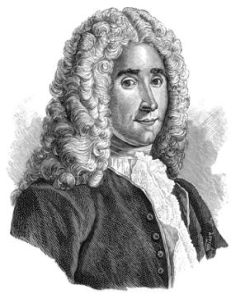Some Biogeographers, Evolutionists and Ecologists:
Chrono-Biographical Sketches
Réaumur,
René-Antoine Ferchault
de (France 1683-1757)
natural history, technology, entomology
 from Wikipedia.org |
Although seldom thought of today, Réaumur was in his own time regarded--correctly--as one of the greatest of scientists. Réaumur did productive work on a remarkable range of subjects, including iron and steel technology, slate-working, porcelain manufacture, egg incubation and preservation, the malleability of metals, tin-plating, temperature measurement (he invented both the Réaumur alcohol thermometer and the Réaumur temperature scale), locomotion in invertebrates, insect behavior (especially of bees), parthenogenesis in aphids, lost limb regeneration, digestion in birds (he showed digestion to be primarily a chemical instead of mechanical process), and much more. His efforts brought many new industries to France, where he was so well thought of that he was made director of the French Academy of Sciences no fewer than twelve times, and subdirector nine times. Réaumur was a forward thinker for his period; he was convinced for example that the government should actively fund science (at that time the pursuit of science was generally viewed as personal avocation) and that such investments would be repaid many times over by the results obtained. He was in fact entirely utilitarian in his motives, and even his studies on insect behavior were justified by looking toward their possible practical implications--for example in pest control or various offshoot industries (silk and honey production, etc.). |
Life Chronology
--born in La Rochelle, France, on 28 February 1683.
--1699-1702: studies law at Bourges
--1703: moves to Paris
--1708: made a member of the French Academy of Sciences
--1710: directs the official description of useful arts and manufactures
in France which is eventually published in numerous volumes as the Description
des Arts et Métiers after his death
--1711: elected pensionnaire mécanicien of the French Academy of
Sciences
--1712: presents a paper on limb regeneration in crayfish
--1713: invents spun glass fibers (such as are still used in fiber optics)
--1719: suggests that paper can be made from wood
--1720: invents the cupola furnace and develops malleable iron
--1722: publishes his L'Art
de Convertir le Fer Forgé en Acier...
--1731: invents the Réaumur thermometer and devises a temperature
scale with zero degrees corresponding to the freezing point of water and
eighty degrees its boiling point
--1734-1742: publishes his Mémoires
pour Servir à l'Histoire des Insectes, in six volumes
--1735: introduces the concept of growing degree-days
--1737: made an honorary member of the Russian Academy of Sciences
--1738: made a member of the Royal Society of London
--1740: invents an opaque form of porcelain
--1741: presents a paper on the regenerative abilities of the hydra
--1750: invents an egg incubator
--1752: isolates gastric juice and discovers the chemical process of digestion
--dies near St.-Julien-du-Terroux, Mayenne, France, on 18 October 1757.
For Additional Information, See:
--Dictionary of Scientific Biography, Vol.
11 (1975).
--A to Z of Scientists in Weather and Climate (2003).
--Historical Metallurgy, Vol. 24(2) (1991): 89-96.
--Eighteenth-Century
Studies, Vol. 18(4) (1985): 503-522.
--Endeavour, Vol. 16(64) (1957): 183-184.
*
*
*
*
*
Copyright 2005 by Charles H. Smith. All rights
reserved.
http://people.wku.edu/charles.smith/chronob/REAU1683.htm
Return to Home/Alphabetical Listing by Name
Return to Listing by Country
Return to Listing by Discipline